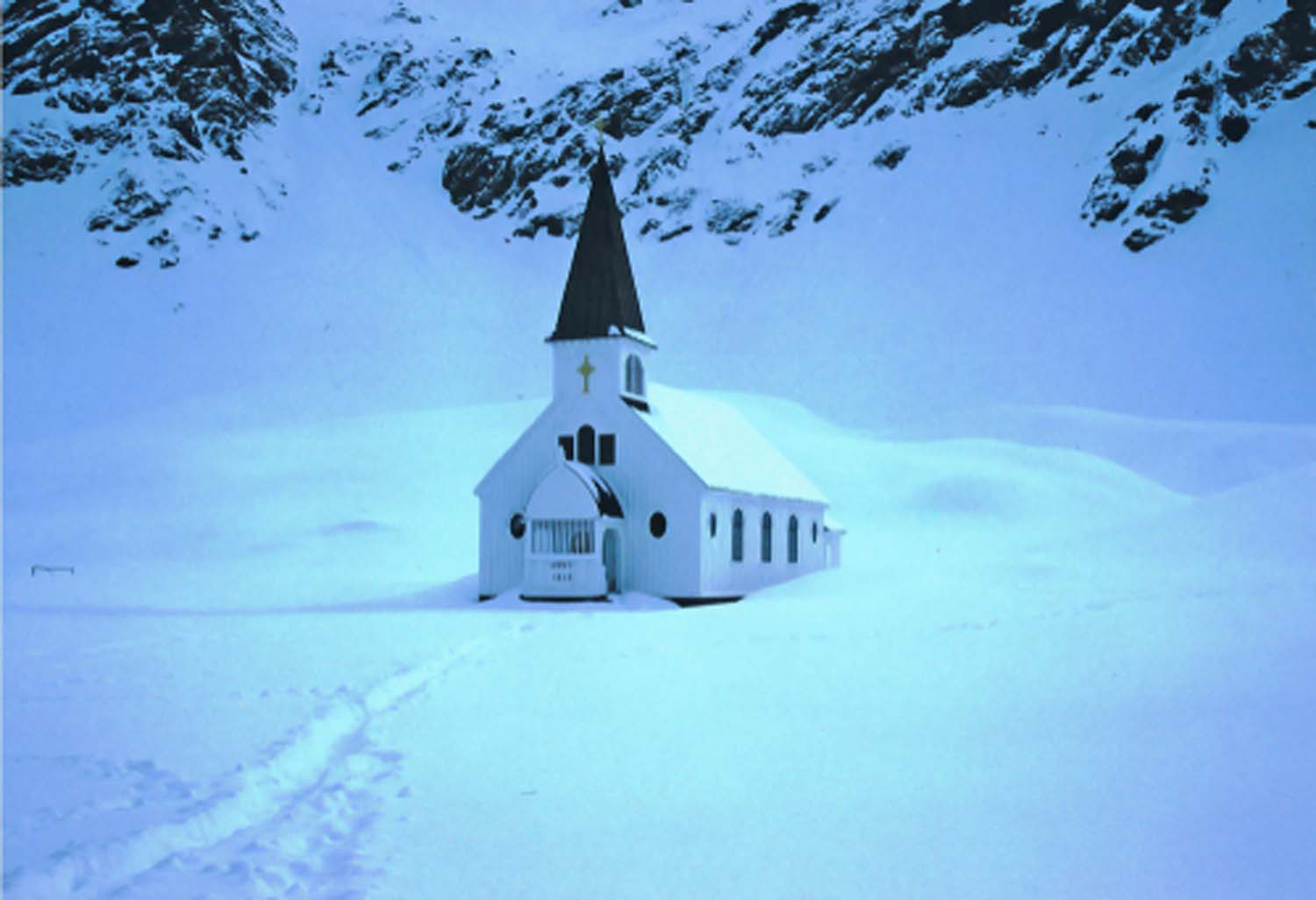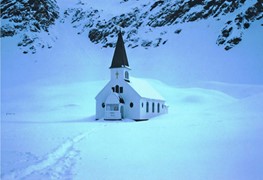Chapel of the Snows
Located on an American science station on Ross Island, this is not the luckiest of churches. Despite being built in an isolated frozen landscape, the church has been destroyed by fire twice.
The original church was devastated in a blaze that started in the heater room while its replacement burnt down after it had been abandoned for several years and caught fire during a severe storm.
The current church was built by the seasonal residents of the station and features custom stained glass showcasing the landscape of Antarctica.
During winter, the station plays host to around 200 people, while summer sometimes sees up to 1,000 visitors. The non-denominational church also does its best to cater to worshippers of all religions.
Click here to learn more about Chapel of the Snows.
 Trinity Chapel
Trinity Chapel
This orthodox church was built in Russia in the 1990s with Siberian pine and transported on a supply ship all the way to the Russian Antarctic station, Bellingshausen, on King George Island.
Two monks from a Russian monastery first volunteered to man the church year-round. Since then, the monastery has rotated priests annually.
Click here to learn more about Trinity Chapel.
Chapel of Our Lady of the Snow at Belgrano II Base
This cave church with walls made of ice is the southernmost place of worship of any religion in the world.
It is the permanent Catholic church for an all-year round Argentinian base and scientific research station founded in 1955 on Coat’s Island. As a result of its latitude, both day and night here are four months long and the night sky often displays the aurora australis.
Click here to learn more about the Chapel of Our Lady of the Snows.
San Francisco de Asis Chapel
The Esperanza Base Station, one of Argentina’s thirteen research bases in Antarctica, is considered by the Argentinians as its southernmost ‘city’ – if you could call it that.
As well as a church, the permanent year-round research base also has a permanent school with teachers, a museum, a bar and a hospital with permanent birth facility where several Argentinians have been born.
While it’s clearly important to the researchers that they stay close to God during their time in Antarctica, they don’t see the harm of having a casino there too, which also serves as a community centre.
Click here to learn more about San Francisco de Asis Chapel.
St Ivan Rilski Chapel, Livingston Island
Hugged by a surrounding wall of snow, this is the church of the Bulgarian base, St Kliment Ohridski.
St Ivan Rilski Chapel was founded in 1988 by a four-member Bulgarian team. Despite looking pretty basic, it comes complete with a chapel bell that was donated by the ex-Vice Premier of Bulgaria who worked as a doctor at the Bulgarian base in the 1993/94 season.
Click here to learn more about St Ivan Rilski Chapel.
Chilian Chapel of Santa Maria Reina de la Paz
Probably one of the few churches in the world made from shipping containers, this is the unusual place of worship of one of the biggest civilian settlements in Antarctica, with a permanent summer population of 120 and a winter population of 80.
Located on the Chilean military base of King George’s Island, Villa las Estrellas is home to several personnel families with children who live there for up to two years at a time. Religious ceremonies are led by a deacon who lives on the base. The town also has a school, a hostel, a post office and a bank.
Click here to learn more about Chilian Chapel of Santa Maria Reina de la Paz.
Catholic Chapel of Santisima Virgen de Lujan at Marambio Base
Posing in front of the steel-structured Catholic chapel on another of Argentina’s research bases, Father Nicholas Daniel Julian sure looks like he could use a better coat!
He helped build the church on the permanent, year-round base, considered Argentina’s most important base on the continent. At the time of its construction it was the first airfield in Antarctica and is still one of the most frequently used ones due to its suitability for a wheeled landing, for which it is called ‘Antarctica’s Entrance Door’.
Click here to learn more about the Catholic Chapel of Santisima Virgen de Lujan.

 The Whalers’ Church
The Whalers’ Church
This Neo-Gothic church was built in 1913 for a whaling station, in Grytviken, a settlement in South Georgia established by a Norwegian sea captain. Erected by the whalers themselves, hence its nickname “Whalers’ Church”, it is the only building in Grytviken which has retained its original purpose since the now abandoned station closed in 1966.
Click here to learn more about The Whalers’ Church.
Want to learn even more about Catholic churches around the world? Click here to learn about and see 10 breathtaking churches from around the world.